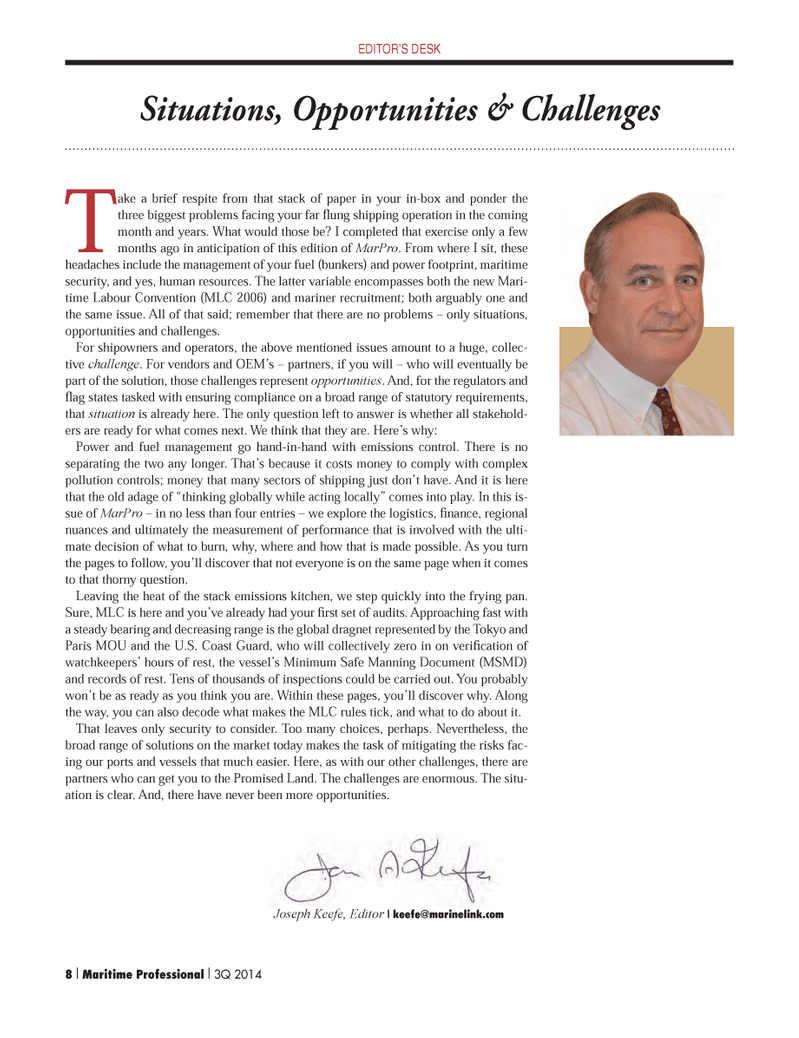
Page 8: of Maritime Logistics Professional Magazine (Q3 2014)
Power & Fuel Management
Read this page in Pdf, Flash or Html5 edition of Q3 2014 Maritime Logistics Professional Magazine
Situations, Opportunities & Challenges EDITOR?S DESK Take a brief respite from that stack of paper in your in-box and ponder the three biggest problems facing your far ß ung shipping operation in the coming month and years. What would those be? I completed that exercise only a few months ago in anticipation of this edition of MarPro . From where I sit, these headaches include the management of your fuel (bunkers) and power footprint, maritime security, and yes, human resources. The latter variable encompasses both the new Mari- time Labour Convention (MLC 2006) and mariner recruitment; both arguably one and the same issue. All of that said; remember that there are no problems Ð only situations, opportunities and challenges.For shipowners and operators, the above mentioned issues amount to a huge, collec- tive challenge . For vendors and OEMÕs Ð partners, if you will Ð who will eventually be part of the solution, those challenges represent opportunities. And, for the regulators and ß ag states tasked with ensuring compliance on a broad range of statutory requirements, that situation is already here. The only question left to answer is whether all stakehold- ers are ready for what comes next. We think that they are. HereÕs why: Power and fuel management go hand-in-hand with emissions control. There is no separating the two any longer. ThatÕs because it costs money to comply with complex pollution controls; money that many sectors of shipping just donÕt have. And it is here that the old adage of Òthinking globally while acting locallyÓ comes into play. In this is- sue of MarPro Ð in no less than four entries Ð we explore the logistics, Þ nance, regional nuances and ultimately the measurement of performance that is involved with the ulti- mate decision of what to burn, why, where and how that is made possible. As you turn the pages to follow, youÕll discover that not everyone is on the same page when it comes to that thorny question. Leaving the heat of the stack emissions kitchen, we step quickly into the frying pan. Sure, MLC is here and youÕve already had your Þ rst set of audits. Approaching fast with a steady bearing and decreasing range is the global dragnet represented by the Tokyo and Paris MOU and the U.S. Coast Guard, who will collectively zero in on veriÞ cation of watchkeepersÕ hours of rest, the vesselÕs Minimum Safe Manning Document (MSMD) and records of rest. Tens of thousands of inspections could be carried out. You probably wonÕt be as ready as you think you are. Within these pages, youÕll discover why. Along the way, you can also decode what makes the MLC rules tick, and what to do about it. That leaves only security to consider. Too many choices, perhaps. Nevertheless, the broad range of solutions on the market today makes the task of mitigating the risks fac- ing our ports and vessels that much easier. Here, as with our other challenges, there are partners who can get you to the Promised Land. The challenges are enormous. The situ- ation is clear. And, there have never been more opportunities. Joseph Keefe, Editor | [email protected] I Maritime Professional I 3Q 20141-17 Q3 MP2014.indd 81-17 Q3 MP2014.indd 88/13/2014 4:00:33 PM8/13/2014 4:00:33 PM

 7
7

 9
9
